Abstract
State anxiety describes a condition when confronted with a specific situation causing genuine concerns. High school students may face such a situation in the preparation for state examinations. Thus, we aimed at not only studying state anxiety in such students, but also at performing psychocorrection of this condition using a specially created programme. The psychocorrection programme is designed to establish the basis for and develop a positive mindset towards the upcoming challenges, or the state examinations, to help students understand their goals and priorities, to teach them techniques of relaxation and muscle and mental tension relief, breathing exercises, and control of emotions. The programme was implemented in the Rudny school No. 2 in the Kostanay region of Kazakhstan. The sample comprised 25 students, including 14 female and 11 male students. We applied the technique proposed by Charles D. Spielberger and adapted by Yu.L. Khanin, the state anxiety scale by Kondas, and the Non-Existent Animal projective technique. As seen from the findings, in the process of psychocorrection the normal level of anxiety started to prevail. The success of state anxiety correction in high school students is linked to the increase in their self-esteem and self-confidence, their mastering of the muscle and mental tension relief techniques, and the development of their self-control skills
Keywords: Psychocorrection programmehigh school studentsanxietyprioritiestechniques of relaxationсontrol of emotions
Introduction
As many specialists believe, adolescence is one of the most crucial stages of formation, development and realization of the personality of an individual (Leontyev, Lebedeva, & Kostenko, 2017; Vianello, Schnabel, Sriram, & Nosek, 2013; Vyatkin & Dorfman, 2017). At this stage, life activity grows drastically and changes its nature, the basic concepts of conscious behaviour are formed, and the general framework of moral views is established. All of it happens against the background of incongruity between mental and physical development. That's why adolescence is described as a transitional stage and a turning point in life. It may be characterized by behavioural inadequacy and ambiguity of attitude. Adults define such characteristics as abnormal and incompatible with social rules (Morrison et al., 2016). Adolescents are also prone to such common internal conflicts as being irreconcilable with iniquity, unfairness and falsehood and eager to fight injustice, but unable to navigate through rough times; having a desire to pursuit the perfection, but being intolerant to edification and direct influence of older generation; wanting to prove oneself, but not knowing how to do it properly; being in need for advice and support, but reluctant to consult with a more experienced adult; and having too many desires and needs, but too little knowledge and expertise to fulfil them.
In adolescence education is considered not only as one of the main types of activity of high school students, but also a source of anxiety (Berzonsky, & Papini, 2014; Lachowicz-Tabaczek, & Bajcar, 2017). Anxiety leads to psychoemotional overstrain, exhaustion, development of neurotic reactions, and increase in illness frequency (Karandashev, Lebedeva, & Spilberger 2004; Morosanova, & Fomina, 2017).
At this age, some adolescents enjoy all school subjects equally and some prefer one particular subject over the others. The latter show a one-sided approach, but it is common for many students.
High school students have different motives regarding their attitude towards their education (Oyserman, Destin, & Novin, 2015; Zhakupova, Dolgova, Kryzhanovskaya, Kondratieva, & Kapitanets, 2017). Primarily these are motives connected with their future, a choice of profession and career path.
As they grow older, students gain more experience and realize that they have an independent life ahead, therefore they become more conscious and start to pay more attention to education. They receive new motivation to study, as they begin to understand that the knowledge will be crucial for a productive life in society (Muravyeva, Litvina, & Bogomaz, 2015; Sokol & Serper, 2017; Zimmerman, & Schunk, 2001).
Students master such cognitive processes as memory, apperception, ideation, imaginative thinking and concentration, that can be used to deal with specific tasks (Sivak & Glazkov, 2017; Trubina, Zeyer, & Mashchenko, 2017).
The main objective of a student is the choice of a future profession and career path (Lyubimov, 2017; Zagvyazinskiy, 2016). Unlike teenagers, high school students already consider their future. They understand that education provides them with opportunities for self-realization.
In high school their approach to education changes as it becomes more future-oriented (Asmolov, 2015; Avraamova & Loginov, 2016; Bolotov 2018; Chamorro-Premuzic & Furnham, 2003). They might start to focus more on such school subjects that relate to their future profession or that are necessary for their admission to a university.
At this age, a direct correlation between the academic and professional interests is established. Based on their choice of profession, high school students display a keen academic interest towards certain subjects. In general, their attitude towards education changes as well. Due to the necessity of self-determination, students get involved in the search for meaning and purpose of their lives and perform a self-analysis (Rudolph & Figge, 2017; Smortchkova, 2017; Vasilenko, Dolgova, Kondratieva, Arkaeva, & Golieva, 2018).
However, at this age many personality disorders develop and become apparent. The duration of emotional reactions and their variety increase. Adolescents tend to showcase a more prominent temper. Although its features are not pathological, they still account for possible deviations in behaviour and increase the risk of psychological trauma and anxiety (Cassady, & Johnson, 2002; Font, Garay, & Jones, 2016; Kiverstein, 2015).
Anxiety is a state of emotional discomfort that is closely connected with foreboding of menace or troubles. There is trait anxiety and state anxiety. State anxiety describes a condition when confronted with a specific situation causing genuine uneasiness. Any person may experience such a condition when faced with challenges and life's problems. Trait anxiety is a condition that is defined by such subjective emotions as concern, unrest and emotional strain. It is an emotional response to a tense and stressful situation that can vary in duration and intensity. An increased level of anxiety, caused by fear of a possible failure and a value judgement from peers and adults, is a coping mechanism that adds to the individual's responsibility to social rules and norms. State anxiety emerges due to objective circumstances with possibility of failure, in particular in situations of assessing the progress and abilities of an individual, such as tests and examinations
Problem Statement
The research problem concerned the development and implementation of such a correction programme that would establish in high school children a positive mindset and determination towards the preparation for state examinations.
Research Questions
The research questions concerned the means of realization of high school students’ psychophysiological capacities including cognitive abilities, emotional and volitional control, relaxation and somatic health.
Purpose of the Study
The purpose of the research was to study state anxiety of high school children in the preparation for state examinations and conduct its psychocorrection with the use of a specially developed programme.
Research Methods
The programme was implemented in the Rudny school No. 2 in the Kostanay region of Kazakhstan. The sample comprised 25 students, including 14 female and 11 male students. The students had different social backgrounds and levels of prosperity, most of them had both parents and one or two siblings. Most of them studied in the same class from the first grade to the eleventh grade. The psychological climate was friendly, with a few minor quarrels and conflicts.
The students developed trusting relationship with their class teacher. They treated her with respect and valued her opinion. The class teacher was responsible for the educational process of the class; she also displayed interest in her students` lives outside the school. The class frequently participated in the scientific and creative activities of the school. In general, the students had good academic performance. During classes they listened to teachers well and were attentive and eager to answer.
We applied three methods (Zabrodin & Pakhalian, 2015): the technique proposed by Charles D. Spielberger and adapted by Yu.L. Khanin, the state anxiety scale by Kondas, and the Non-existent Animal projective technique.
We developed a psychocorrection programme. The objective of the programme was to conduct psychocorrection of state anxiety of high school students in the preparation for state examinations.
To achieve the named objective, we set the following goals:
1. to develop in students skills necessary to deal with the state of anxiety,
2. to minimize the negative attitude towards examinations,
3. to form a positive mindset towards the upcoming state examinations,
4. to increase their self-confidence,
5. to increase their self-esteem,
6. to teach them methods and techniques of relaxation,
7. to relieve mental, emotional and muscle tension,
8. to teach methods of reducing muscle spasms,
9. to help students perform self-analysis and understand personal goals and priorities,
10. to develop their cognitive processes including memory, concentration and imaginative thinking.
The sample comprised 25 students from the eleventh grade. It consisted of 14 female students and 11 male students of age 17-18. Based on the performed tests, 9 students with a high level of anxiety were recommended to participate in the programme. However, all the students showed their willingness to take part in the programme with preventive purpose. The group classes lasted from 60 to 90 minutes depending on the number and difficulty of exercises and were held three times a week. The overall number of classes was 10. The students worked in one group. The classes included lectures, games, discussions, drawing, relaxation and work in group. We used interactive equipment and stationery.
Day 1. Class 1. Introduction. The goal was to establish trusting relationships between the students, familiarize them with the rules of group work and create a friendly atmosphere in the group. Greetings. Exercises: 1. Let Me Introduce Myself. The goal was to introduce the students to each other and establish a trusting atmosphere. 2. We Have Gathered Here Together to... The goal was to familiarize the students with the objectives of the training, develop rules of group work and choose a mascot. 3. The Path of Life. The goal was to increase the level of trust between the students and decrease the level of anxiety. 4. Group Drawing. The goal was to create a feeling of mutual responsibility and joy from the achieved results. End of the class. Self-analysis. The goal was to receive some feedback through the passing of the mascot and describing the state of mind. Parable of the day: Grape Seeds.
Day 2. Class 2. Examination Equals Anxiety. Greetings. The goal was to prepare students for the upcoming stressful situation in the form of an examination. Exercises: 1. I Wish... The goal was to create a positive mood in the group. 2. Associations. The goal was to let the students share their opinions, thoughts and feelings regarding the examinations. 3. Ranking the Feelings. The goal was to analyse the attitude of the students towards the examinations. 4. Interview with Anxiety. The goal was to understand what anxiety means to each student. 5. Pocketful of Happiness. The goal was to gain confidence in own abilities and skills and express a personal opinion on which ones can help with dealing with anxiety. Self-analysis. Mascot. State of mind. Parable of the day: About a Well.
Day 3. Class 3. A Good Day. The goal was to teach the students to not only focus on failures but acknowledge personal achievements as well. Greetings. Exercises: 1. Modified Charades. The goal was to improve the mood in the group, do warm-up and demonstrate an unusual approach to a known game. 2. Bees and Flies. The goal was to teach the students to look on the bright side and form in them a positive approach to life. 3. Three Reasons for Joy. The goal was to form a positive thinking and teach the students to look on the bright side. 4. Foundations for Positive Thinking. The goal was to form the foundations for positive thinking. Self-analysis. Mascot. State of mind. Parable of the day: The Butterfly Effect.
Day 4. Class 4. All Things Must Pass. The goal was to form a positive mindset towards the upcoming state examination. Greetings. Exercises: 1. Give a Present. The goal was to establish a friendly atmosphere of interaction. 2. Ranking the Emotions. The goal was to help the students figure out their emotions, rank them and realize what place anxiety has. 3. Ten Words. The goal was to form a positive mindset towards the upcoming state examination. 4. My Resources. The goal was to help the students identify what personal qualities would be helpful in the preparation for the state examination. 5. Words of Support. The goal was to teach the students to be own personal support in the preparation for the examinations. Self-analysis. Mascot. State of mind. Parable of the day: Always Look on the Bright Side.
Day 5. Class 5. I am a Sunbeam. The goal was to enhance the feeling of personal importance and increase the self-confidence and self-esteem. Greetings. Exercises: 1. Three Adjectives. The goal was to establish a friendly atmosphere, improve the mood and prepare the group for the upcoming exercises. 2. Casting. The goal was to improve the feeling of personal importance. 3. Self-Esteem Chart. The goal was to show the students what qualities they have and to what extent. 4. The Sun of My Own Self. The goal was to appreciate personal importance. 5. Magical Chair. The goal was to experience the feeling of being the centre of attention. Self-analysis. Mascot. State of mind. The parable of the day: Be Yourself.
Day 6. Class 6. Personal Growth. The goal was to help the students perform self-analysis and understand personal goals and priorities. Greetings. Exercises: 1. If I Were a Hippie... The goal was to establish a friendly atmosphere and relieve tension. 2. One More Week of Being Alive. The goal was to reflect on personal priorities and set new objectives. 3. Peeling Onions. The goal was to help the students understand who they are, analyse their inner selves and acknowledge their goals and needs. 4. Perfect Students. The goal was to share an opinion on a perfect student and form the qualities a perfect student must obtain. 5. The Tree of Life. The goal was to realize that everything that happens in our lives is influenced by the purpose of our lives. Self-analysis. Mascot. State of mind. The parable of the day: Two Eagles.
Day 7. Class 7. Play and Learn. The goal was to develop cognitive processes, concentration, memory and imaginative thinking. Greetings. Exercises: 1. Share a Smile. The goal was to establish a friendly atmosphere in the group. 2. Sit Down! Stand Up! The goal was to develop concentration and logical thinking and learn to understand one another without words. 3. My Neighbour on the Right. The goal was to conduct a memory game. 4. Sheds Out of Matches. The goal was to develop concentration, teach the group to address a situation as a whole and approach it with a fresh perspective. 5. Transformation. The goal was to develop imaginative thinking. 6. Good Memory (Ivan Petrovich). The goal was to develop memory and realize the effectiveness of different techniques of memorization. Self-analysis. Mascot. State of mind. The parable of the day: Those Who Know Do Not Speak, Those Who Speak Do Not Know.
Day 8. Class 8. Relaxing Productively. The goal was to teach the students techniques of relaxation and muscle and mental tension relief, breathing exercises and control of emotions. Greetings. Exercises: 1. Weather Forecast. The goal was to establish a friendly atmosphere in the group. 2. We Are in the Lead. The goal was to relieve mental tension. 3. Blow Out the Candles. The goal was to relieve tension. 4. Control of Emotions. The goal was to learn to control emotions and be a master of own life and understand how to apply it in the situation of examinations. 5. Reaching the Stars. The goal was to relieve psychological and emotional tension, reduce muscle spasms and master self-reflection. Self-analysis. Mascot. State of mind. The parable of the day: A Can of Life.
Day 9. Class 9. The goal was to relieve tension and anxiety and form a positive mindset before examinations. Greetings. Exercises: 1. Massage. The goal was to relieve tension and create a positive mood in the group. 2. Anti-Anxiety Vaccination, or Passing Examinations Successfully. The goal was to relieve anxiety and help the students visualise the situation of examinations. 3. We Do Not Fear Examinations. The goal was to draw recommendations for reducing the feeling of anxiety due to the upcoming examinations. 4. I Am Capable of Everything (autogenic training). The goal was to establish a positive mindset before the examinations and increase the self-confidence. 5. Musical Relaxation. The goal was to relieve tension with the use of music therapy. Self-analysis. Mascot. State of mind. Parable of the day: The Ring of Solomon.
Day 10. Class 10. Goodbye, My Friend, Goodbye! The goal was to summarize the experience and the received knowledge and give the students further guidance. Exercises: We Are a Family, or a Friendly Community. The goal was to establish a positive mood. 2. Black Box, or Farewell Anxiety. The goal was to relieve tension and anxiety. 3. Positive Mindset. The goal was to form a positive attitude towards examinations. 4. Packing a Backpack. The goal was to realize the received information and extract the most important parts that would help with preparing for and taking the state examination. 5. Mascot. The goal was to choose a mascot to attract success. 6. Heart. The goal was to finish the last class with a celebration. Self-analysis. Mascot. State of mind. The parable of the day: Coffee and Hot Water
Findings
The findings based on the technique proposed by Charles D. Spielberger and adapted by Yu.L. Khanin, are presented in Figure
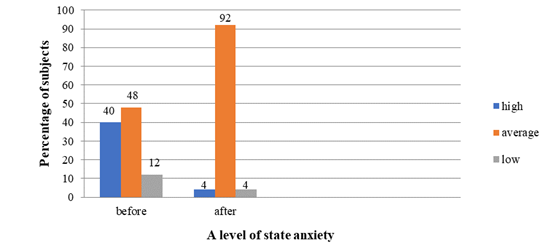
The percentage of a high level of anxiety dropped by 36% as it was found only in one person after the implementation of the programme. Students with a high level of anxiety tend to feel anxious in a situation of evaluation of their competences. They do not have confidence in themselves and their success.
The percentage of an average level of anxiety grew by 44% to 92%. The explanation might be that every person has a personal optimal level of anxiety called useful anxiety. In a situation of criticism students with an average anxiety level learned to response constructively; they adequately showed concern regarding the results of their activities.
The percentage of a low level of anxiety dropped as well as it was found only in one student. It indicated a low level of responsibility and a lack of fear and concern.
The findings based on the Non-Existent Animal projective technique before and after the implementation of the programme are shown in Figure
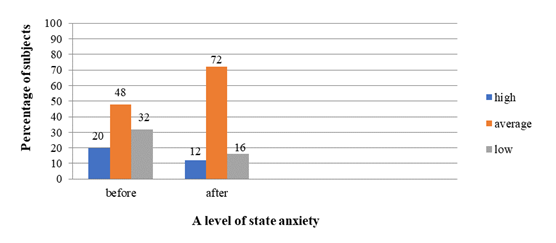
The percentage of a high level of anxiety decreased from 20% to 12%. The students with a high level of anxiety used such details in the drawings that indicated signs of anxiety (claws, sharp fangs and teeth). Together with applying too much pressure on the pencil when drawing it showed aggression. Such details as big eyes symbolized fear, dread and lack of trust for other people.
The percentage of an average level of anxiety increased from 48% to 72%. Such details as no fangs, small claws and lack of sharp angles became more frequent in the drawing of these students. It showed reduction in anxiety. The usage of light and minimalistic shading further proved that the students became more composed.
The percentage of a low level of anxiety dropped from 32% (found in 8 subjects) to 16% (found in 4 subjects). There were no details in the drawings of these students that would indicate aggression (teeth, horns, claws). They used smooth lines instead of sharp ones, and various types of shading. The latter demonstrated adaptability to new environment and flexibility in school and life activities.
The findings on school anxiety in high school children based on the Kondas technique are shown in Figure
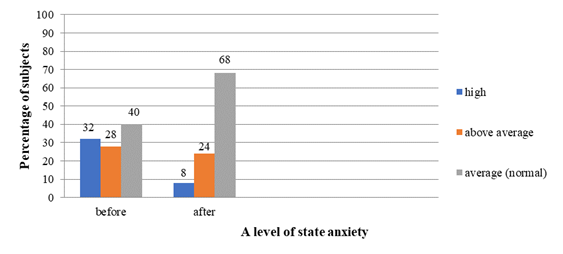
The percentage of a high level of anxiety dropped from 32% to 8%. A high anxiety level remained in two students. They are reluctant to attend classes, have school-related nightmares and show negative attitude towards peers and teachers.
The percentage of an above average level of anxiety decreased from 28% to 24%. These students doubt their knowledge and are afraid to speak in class and participate in discussions if they did not understand new material. They are too intimidated to ask the teacher to repeat what was said, and in general have difficulties in interacting with teachers. They feel uncomfortable in company of leaders and care about the opinions of their peers.
The percentage of an average, or normal level of anxiety increased by 28% from 40% to 68%. These students became more emotionally stable and more confident in their knowledge, started to speak in classes and interact with their peers and teachers.
A very high and a very low levels of anxiety were not detected.
The findings on self-evaluated anxiety based on the Kondas technique are showed in Figure
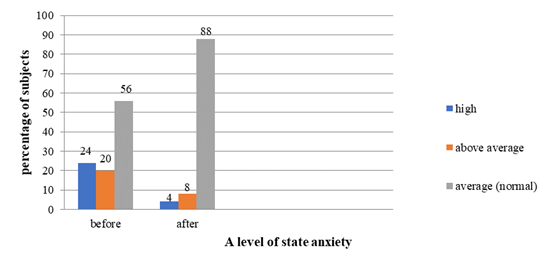
The percentage of a high anxiety level dropped from 24% to 4%, and after the implementation of the programme it was found in one student only. He feels anxious when being assessed, has a low self-esteem and problems with self-confidence.
The percentage of an above average level of anxiety also dropped from 20% to 8%. Two students are still afraid to participate in competitions and contests and scared of rejection. They tend to avoid school events.
The percentage of an average level of anxiety increased drastically from 56% (14 subjects) to 88% (22 subjects). These students rarely have any difficulties.
A very high and a very low levels of anxiety were not detected.
The findings on interpersonal anxiety based on the Kondas technique are showed in Figure
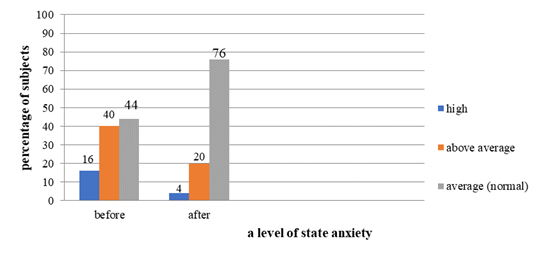
A high level of interpersonal anxiety was found in 4 subjects before the programme and in 1 subject after the programme (16% and 4% relatively). The subject continued to have difficulties in interacting with teachers and peers and worry about their opinions.
The percentage of an above average level of interpersonal anxiety dropped from 40% to 20%. The number of students with difficulties in making decisions and meeting new people halved. These students feel comfortable with their close friends.
The percentage of an average anxiety level increased from 44% (11 subjects) to 76% (19 subjects). In general, these students do not face any difficulties in interpersonal communication.
A very high and a very low levels of anxiety were not detected.
The findings on total anxiety based on the Kondas technique are showed in Figure
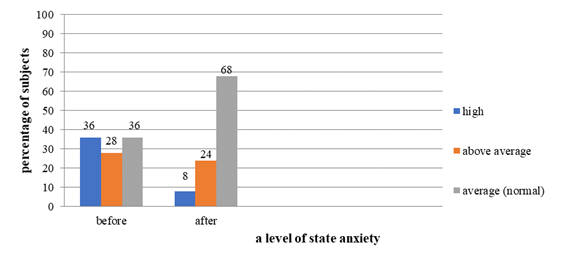
The percentage of a high level of total anxiety dropped from 36% to 8%. There remained 2 students who still have difficulties in comprehending new material explained by a teacher and feel anxious when being assessed. They are ignored and left out by their peers and often have school-related nightmares.
The percentage of an above average anxiety level decreased from 28% to 24%, however, this person still has a high level of some elements of anxiety. Another person still has a careless approach to studying and lacks initiative.
The percentage of an average anxiety level increased from 36% to 68%. The number of students who started to feel more confident when answering before the class and less doubtful about their answers, became more eager to participate in competitions and to overcome difficulties in interpersonal communication almost doubled.
Therefore Figures
Conclusion
The psychocorrection programme was designed to establish the basis for and develop a positive mindset towards the upcoming state examinations, to help students understand their goals and priorities, to teach them techniques of relaxation and muscle and mental tension relief, breathing exercises, and control of emotions.
As seen from the findings, in the process of psychocorrection the normal level of anxiety started to prevail.
The success of state anxiety correction in high school students is linked to the increase in their self-esteem and self-confidence, their mastering of the muscle and mental tension relief techniques, and the development of their self-control skills.
Acknowledgments
The article is written in the framework of the Scientific and Methodological Foundations of Psychology and Management Technology of Innovative Educational Processes in the Changing World scientific project of the comprehensive plan of research, project and organizational activities of the research centre of Russian Academy of Education in the South Ural State Humanitarian Pedagogical University for 2018-2020 (Grant from the Mordovia State Pedagogical Institute named after M. E. Evsevyev Grant theme: Personal resources for overcoming the development crisis by the subjects of the educational process (2019; head Dolgova V.I.).
References
- Asmolov, A. G. (2015). Activity as reality in defining people and activity as a cognitive construct. Activity and the activity approach to understanding people: the historical meaning of the crisis of cultural-activity psychology. Russian education and society, 57(9), 731-756. DOI: 10.1080/10609393.2015.1125706
- Avraamova, E. M., & Loginov, D. M. (2016). Novyye tendentsii v razvitii shkolnogo obrazovaniya. o dannym ezhegodnogo monitoringovogo issledovaniya tsentra ekonomiki nepreryvnogo obrazovaniya RANKhIGS. [New trends in school education development based on the annual monitoring research conducted by the Center of Economy of Continuous Education of the Presidential Academy of National Economy and Public Administration (RANEPA)]. Educational studies, 4, 163-185. [in Rus.] DOI: 10.17323/1814-9545-2016-4-163-185
- Berzonsky, M. D., & Papini, D. R. (2014). Identity processing styles and value orientations: the mediational role of self-regulation and identity commitment. An international journal of theory and research, 14(2), 96-112. DOI: 10.1080/15283488.2013.858228
- Bolotov, V. A. (2018). Proshloye. nastoyashcheye i vozmozhnoye budushcheye rossiyskoy sistemy otsenki kachestva obrazovaniya. [The past, present and possible future of the Russian system of education quality assessment]. Educational studies, 3, 287-297. [in Rus.]
- Cassady, J. C., & Johnson, R. E. (2002). Cognitive test anxiety and academic performance. Contemporary educational psychology, 27(2), 270-295.
- Chamorro-Premuzic, T., & Furnham, A. (2003). Personality traits and academic examination performance. European journal of personality, 17(3), 237-250.
- Font, X., Garay, L., & Jones, S. (2016). A Social Cognitive Theory of sustainability empathy. Annals of tourism research, 58, 65-80. DOI: 10.1016/j.annals.2016.02.004
- Karandashev, V. N., Lebedeva, M. S., & Spilberger, C. (2004). Izuchenie otsenochnoy trevozhnosti: rukovodstvo po ispol'zovaniyu metodiki Ch.Spilbergera [Evaluation study of anxiety: a guide to the use of Ch. Spilberger's techniques]. St. Petersburg: Speech. [in Rus.]
- Kiverstein, J. (2015). Empathy and the responsiveness to social affordances. Consciousness and cognition, 36, 532-542. DOI: 10.1016/j.concog.2015.05.002
- Lachowicz-Tabaczek, K., & Bajcar, B. (2017). Future self-appraisals and global self-esteem: Who benefits more from thinking about the future, and why? Self and identity, 16(4), 460-479. DOI: 10.1080/15298868.2016.1270850
- Leontyev, D. A., Lebedeva A. A., & Kostenko, V. Y. (2017). Trayektorii lichnostnogo razvitiya: rekonstruktsiya vzglyadov L.S. Vygotskogo. [Pathways of personality development: following Lev Vygotsky's guidelines]. Educational studies, 2, 98-112. [in Rus.] DOI: 10.17323/1814-9545-2017-2-98-112
- Lyubimov, L. L. (2017). Kniga. v kotoroy nuzhdayetsya kazhdaya shkola. Retsenziya na knigu: A. A. Leontyev. Pedagogika zdravogo smysla. Izbrannyye raboty po filosofii obrazovaniya i pedagogicheskoy psikhologii [The book that every school needs. Review of the Russian edition of the book: Leontiev A. Pedagogy of common sense. Selected works on philosophy of education and educational psychology]. Educational studies, 3, 234-241. [in Rus.] DOI: 10.17323/1814-9545-2017-3-234-241
- Morosanova, V. I., & Fomina, T. G. (2017). Samoregulyatsiya kak posrednik v otnosheniyakh mezhdu trevozhnostyu i uspevayemostyu. [Self-regulation as a Mediator in the Relationship Between Anxiety and Academic Examination Performance]. Procedia, Social and behavioral sciences, 237, 1066-1070. [in Rus.]
- Morrison, A. S., Mateen, M. A., Brozovich, F. A., Zaki, J., Goldin, P. R., … Gross, J. J. (2016). Empathy for positive and negative emotions in social anxiety disorder. Behaviour research and therapy, 87, 232-242. DOI: 10.1016/j.brat.2016.10.005
- Muravyeva, O. I., Litvina, S. A., & Bogomaz, S. A. (2015). Sredovaya identichnost: soderzhaniye ponyatiya. [Environmental identity: the concept content]. Siberian journal of psychology, 58, 136-148. [in Rus.] DOI: 10.17223/17267080/58/10
- Oyserman, D., Destin, M., & Novin, S. (2015). The context-sensitive future self: possible selves motivate in context, not otherwise. Self and identity, 14(2), 173-188. DOI: 10.1080/15298868.2014.965733
- Rudolph, A., & Figge, L. (2017). Determinants of ecological footprints: What is the role of globalization? Ecological indicators, 81, 348-361. DOI: 10.1016/j.ecolind.2017.04.060
- Sivak, E. V., & Glazkov, K. P. (2017). Zhizn vne klassa: povsednevnaya mobilnost shkolnikov. [Life outside the classroom: everyday mobility of school students]. Educational studies, 2, 113-133. [in Rus.] DOI: 10.17323/1814-9545-2017-2-113-133
- Smortchkova, J. (2017). Encapsulated social perception of emotional expressions. Consciousness and cognition, 47, 38-47. DOI: 10.1016/j.concog.2016.09.006
- Sokol, Y., & Serper, M. (2017). Temporal self-appraisal and continuous identity: associations with depression and hopelessness. Journal of affective disorders, 208, 503-511. DOI: 10.1016/j.jad.2016.10.033
- Trubina, G. P., Zeyer, E. F., & Mashchenko, M. V. (2017). Sotsialno-oriyentirovannyy podkhod v obrazovanii kak usloviye uspeshnoy sotsializatsii uchashchegosya. [Socially-oriented approach to education as a condition of successful socialization of pupils]. Education and science, 19(6), 9-32. [in Rus.] DOI:
- Vasilenko, E. A., Dolgova, V. I., Kondratieva, O. A., Arkaeva, N. I., & Golieva, G. Y. (2018). Factors contributing to a stronger experience of environmental stress by high school students. Espacios, 39(02), 10.
- Vianello, M., Schnabel, K., Sriram, N., & Nosek, B. (2013). Gender differences in implicit and explicit personality traits. Personality and individual differences, 55(8), 994-999. DOI: 10.1016/j.paid.2013.08.008
- Vyatkin, B. A., & Dorfman, L. Y. (2017). Teoriya integral’noy individualnosti V. S. Merlina: istoriya i sovremennost’. [Theory of integral individuality by V. S. Merlin: history and nowadays]. The education and science journal, 2, 145-160. [in Rus.] DOI: 10.17853/1994-5639-2017-2-145-160
- Zabrodin, Y. M., & Pakhalian, V. E. (2015). Psikhodiagnostika: spravochnik. [Psychognosis: reference book]. Saratov, Russia: Tertiary education. [in Rus.]
- Zagvyazinskiy, V. I. (2016). O tsennostno-oriyentatsionnykh osnovaniyakh obrazovatelnoy sistemy strany. [Valuable and orientation foundations of educational system of the country]. Education and science, 6, 11-22. [in Rus.] DOI: 10.17853/1994-5639-2016-6-11-22
- Zhakupova, Y. T., Dolgova, V. I., Kryzhanovskaya, N. V., Kondratieva, O. A., & Kapitanets, E. G. (2017). Gifted adolescents: Special qualities of the cognitive activities’ motivational component. Espacios. 38(40), 22.
- Zimmerman, B. J., & Schunk, D. H. (2001). Reflections on theories of self-regulated learning and academic achievement. Self-regulated learning and academic achievement: Theoretical perspectives, 2, 289-307
Copyright information

This work is licensed under a Creative Commons Attribution-NonCommercial-NoDerivatives 4.0 International License.
About this article
Publication Date
02 December 2019
Article Doi
eBook ISBN
978-1-80296-072-3
Publisher
Future Academy
Volume
73
Print ISBN (optional)
-
Edition Number
1st Edition
Pages
1-986
Subjects
Communication, education, educational equipment, educational technology, computer-aided learning (CAL), Study skills, learning skills, ICT
Cite this article as:
Dolgova*, V., Kondratieva, O., Kozhurova, D., & Kapitanets, E. (2019). Psychocorrection Of Anxiety Of High School Students In Preparation For State Examinations. In N. I. Almazova, A. V. Rubtsova, & D. S. Bylieva (Eds.), Professional Сulture of the Specialist of the Future, vol 73. European Proceedings of Social and Behavioural Sciences (pp. 276-288). Future Academy. https://doi.org/10.15405/epsbs.2019.12.30
